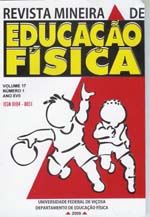EFFECTS OF GENDER ON THE DYNAMIC BALANCE OF CHILDREN WITH SCHOOL AGE
Keywords:
child, postural balance, educationAbstract
The aim of the study was to compare the effects of gender on the dynamic balance between boys and girls. Participated in the primary study, quantitative and cross-sectional 40 children aged between 7 and 10 years, belonging to public school. To check the weight and the height, were used a scale Filizola® and a tape measure. For the balance test, the individual jumped at the first mark and landed on with the leg indicated on tiptoe, and had to stay in this position until 5 seconds and so on, from a mark to another. For statistical analysis, was used the independent Student test, and for nonparametric data, was used the Mann-Whitney test. We observe that the dynamic balance showed a significant difference when comparing boys and girls. We conclude that the dynamic equilibrium is significantly different between boys and girls
Downloads
References
ARAÚJO, M.P.; BARELA, J.A.; CELESTINO, M.L.; BARELA, A.M.F. Contribution of differents contents of physical education classes in elementary school I for the development of basic motor skills. Revista Brasileira de Medicina do Esporte, v. 18, n. 3, p. 153-157, 2012.
BESSA, M.F.S.; PEREIRA, J.S. Equilíbrio e coordenação motora em pré-escolares: um estudo comparativo. Revista Brasileira de Ciência e Movimento, v. 10, n. 4, p. 57-62, 2002.
BUTZ, S.M.; SWEENEY, J.K.; ROBERTS, P.L.; RAUH, M.J. Relationships among age, gender, anthropometric characteristics, and dynamic balance in children 5 to 12 years old. Pediatric Physical Therapy, v. 27, n. 2, p. 126-133, 2015.
CARMO, N.; GRINGER, C.; SOUZA NETO, J.B.; FRANÇA, J.C.; VICTORINO, R.; PEREIRA, C.C.D.A. A importância da Educação Física Escolar sobre aspectos de saúde: sedentarismo. Revista Educare CEUNSP, v. 1, n. 1, p. 21-29, 2013.
DREWS, R.; CARDOZO, P.; CORAZZA, S.T.; KATZER, J.I.; MEZZOMO, S.P. Equilíbrio e flexibilidade em escolares praticantes de educação física e ballet clássico. Revista Digital, v. 15, n. 150, p. 1, 2010.
GALLAHUE, D.L.; OZMUN, J.C. Compreendendo o desenvolvimento motor: bebês, crianças, adolescentes e adultos. São Paulo: Phorte, 2002.
GÖKDEMIR, K.; CIGERCI, A.E.; ER, F.; SUVEREN, C.; SEVER, O. The comparison of dynamic and static balance performance of sedentary and different branches athletes. World Applied Sciences Journal, v. 17, n. 9, p. 1079-1082, 2012.
HARTMAN, E.; HOUWEN, S.; VISSCHER, C. Motor skill performance and sports participation in deaf elementary school children. Adapted Physical Activity Quarterly, v. 28, n. 2, p. 132-45, 2011.
JOHNSON, B.L.; NELSON, J.K. Pratical measurements for evaluation in physical education. United States of America: Burgess Publishing, 1979.
MELO, R.S.; LEMOS, A.; RAPOSO, M.C.F.; FERRAZ, K.M. Desempenho do equilíbrio dinâmico de escolares ouvintes e com perda auditiva sensorioneural. Revista Brasileira de Medicina do Esporte, v. 20, n. 6, p. 442-446, 2014.
PRANKE, G. L.; LEMOS, G. Equilíbrio corporal em crianças. Foz do Iguaçu: Revinter, 2007.
RAJENDRAN, V.; ROY, F.G.; JEEVANANTHAM, D. Postural control, motor skills, and health-related quality of life in children with hearing impairment: a systematic review. European Archives Of Otorhinolaryngology, v. 269, n. 4, p. 1063-1071, 2012.
REBELATTO, J.R.; CASTRO, A.P.; SAKO, F.K.; AURICHIO, T.R. Equilíbrio estático e dinâmico em indivíduos senescentes e o índice de massa corporal. Fisioterapia em Movimento, v. 21, n. 3, p. 69-75, 2008.
SILVA, M.C.R.; CORAZZA, S.T.; KATZER, J.I.; MOTA, C.B.; SOARES, J.C. Equilíbrio corporal em crianças e adolescentes asmáticos e não asmáticos. Motriz, v. 19, n. 2, p. 480-486, 2013.
VENETSANOU, F.; KAMBAS, A. The effects of age and gender on balance skills in preschool children. Physical Education and Sport, v. 9, n. 1, p. 81-90, 2011.
Downloads
Published
How to Cite
Issue
Section
License
Os artigos submetidos e publicados são de inteira responsabilidade de seus autores, não refletindo necessariamente a opinião do Comitê Editorial. A revista se reserva o direito de efetuar, nos originais, alterações de ordem normativa, ortográfica e gramatical, com vistas a manter o padrão culto da língua, respeitando, porém, o estilo dos autores. O manuscrito submetido deve ser original, não podendo ter sido publicado em qualquer outro veículo de informação científica, e nem submetido para publicação em outra revista científica. Os trabalhos publicados passam a ser propriedade da revista Mineira de Educação Física, ficando sua reimpressão total ou parcial de acordo com a licença Creative Commons Attibution 4.0. Deve ser consignada a fonte de publicação original. Os originais não serão devolvidos aos autores. As opiniões emitidas pelos autores dos artigos são de sua exclusiva responsabilidade.





 Esta obra está licenciada com uma Licença
Esta obra está licenciada com uma Licença 